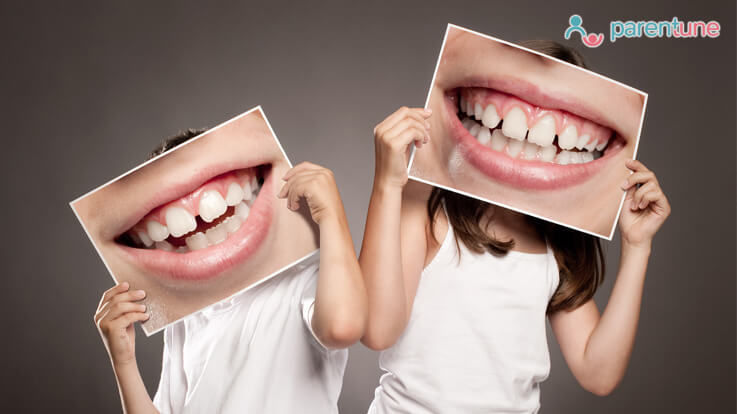Dental plaque in children

Oral and dental hygiene in children must begin even before their first teeth appear. Wiping your baby's gums with a clean, wet washcloth helps keeps germs at bay. Starting early lays the foundation for good oral hygiene later, too. Your child is prone to the same dental problems that an adult can experience. Plaque, in particular, is extremely common, but also quite easy to avoid with proper care.
What Is Dental Plaque?
Dental plaque is a collection of bacteria, which appears as sticky colorless film on the surface of teeth. Since it can't be seen by a naked eye, it is often missed. However, it may pronounced when it gets stained by the food items and appear as a yellowish or brownish deposit on the teeth along the margins of the gums. Dental plaque makes the surface of teeth appear dull or fuzzy, rather than smooth and shiny.
Over a period of time, the plaque may get hardened to form tartar, also known as calculus. Tartar is usually formed in lower front teeth or upper back teeth.
Where Is Dental Plaque Formed?
Dental plaque is formed on fissures and grooves of your child's teeth and along the margins of gums (gingival crevice). It stays more on places where a toothbrush does not reach, such as grooves and fissures.
Dental pellicle which is a precursor to dental plaque, starts forming within seconds of brushing. Dental plaque is formed within 2 hours of brushing.
What Can Dental Plaque Lead To?
Dental Plaque can be a starting point for other dental issues. Here are some of the other problems that can result due to dental plaque.
- Enamel breakdown: Dental plaque can lead to a gradual breakdown of enamel. It so happens when a child eats sweets, the dental plaque along with sweet produces an acid. This acid when left in the mouth starts attacking the enamel resulting in a gradual breakdown of an enamel thus causing cavities
- Inflammation of gums: Dental plaque if left untreated may also cause inflammation of gums. Inflammation of gums is seen as mild puffiness on the gums along with redness. Apart from a mild puffiness on the gums, if dental plaque left untreated, may result in gums bleeding when touched with bristles of a toothbrush. Dental plaque in children is slightly different from that in adults. Inflammation of gums in response to plaque is lower in preschoolers than in adults. It forms more rapidly in children aged 8-12 years than in adults
- Affects teeth and bone structure: The continued build-up of plaque can even have an impact on the structure of the teeth and the bone that supports the teeth

How To Remove Dental Plaque?
There are numerous ways dental plaque can be removed from your child's teeth. Below mentioned are the ways you can do remove dental plaque from your child's teeth.
- Toothbrush with nylon bristles: Dental plaque is thin and fragile, and hence can be easily removed with a toothbrush with nylon bristles. The technique of brushing is very important to remove the plaque properly. Toothbrush should be changed every 3 months. Teach your child to brush twice every day
- Cloth comes handy: In infants the plaque can be removed by rubbing surfaces of teeth with a cloth. Use a soft muslin cloth for the purpose and wipe your baby's teeth with this cloth post every feed
- Flossing is important: While brushing is important, flossing is all the more necessary, as flossing cleans the surface where toothbrush can't reach
- Mouthwash for an oral hygiene: Since plaque is formed by the bacteria in the mouth, ensure your child to use an antibacterial mouthwash. Teach him or her to use one by using it yourself. Your child will love the gurgling part and will have a hygienic mouth by reducing the formation of bacteria thereby reducing the plaque formation on teeth
- Munch on the crunchy foods: Eating crunchy fruits and vegetables helps in minimizing formation of plaque. So let your child chew on that carrot, and cucumber. Not only are they good for your teeth, they are also good for your child's overall health
- Regular visit to a dentist: Don't forget to plan a visit to your dentist every 6 months so that he or she can medically clean the plaque from your child's teeth
- Dental sealants: Dental sealants (dental sealants are a treatment offered to reduce tooth cavity) can be placed in the grooves and fissures of teeth, thereby preventing plaque from forming in these areas
When you begin teaching your child dental care at an early age, it pays off in the long run. Your child's food habits play an important role in oral hygiene, too. Avoid sugar-laden snacks and beverages, as sugar damages the enamel, and leads to a cavity. So make an appointment with your pediatric dentist today!
Did you find these tips on managing dental plaque by Dr Kunal Gupta, useful? Let us know in the comments section!
Be the first to support
Be the first to share
Comment (0)
Related Blogs & Vlogs
No related events found.
Loading more...